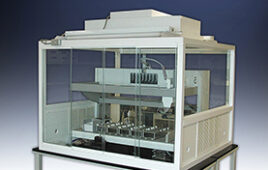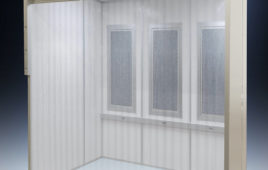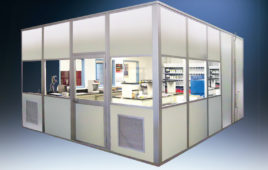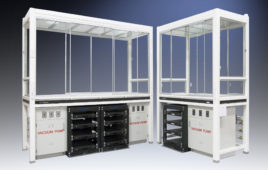When the Birck Nanotechnology Center (BNC) at Purdue University in West Lafayette, Ind. was completed in 2005, it set a new standard in the design and operation of higher education research facilities. At the dedication ceremony, Mihail Roco, senior advisor for the Nanotechnology National Science Foundation, called it “the epitome of a university-based research facility focusing on the growing discipline of nanotechnology. It is a facility that will become the model for how universities answer critical questions in the exciting and dynamic arena of nanotechnology.” Two years after its completion, the BNC was named Facility of the Year by Controlled Environments Magazine; not only for its technological advancements, but also for its forward-looking design for interdisciplinary project-based research.
Starting with the early design phases, it was clear to the Purdue faculty, administration, and technical staff that the BNC focus on interdisciplinary research was paramount. Facility researchers look to create nanotechnologies addressing computing, communications, the environment, security, energy independence, and health. Although interdisciplinary research is not unique to Purdue, this project adopted a top-down and bottom-up approach that is embedded in the culture of the research community, the project organization, and the physical design of the building.
The building was purposely placed on neutral ground in a newly developed Discovery Park, located at the outskirts of the departmentally clustered main campus. Researchers assigned to the building are from many academic backgrounds to encourage collaboration.
The design strategically locates areas intended for collaboration in the midst of nodes of activities. Transparency in the building design maximizes visibility throughout the facility. All scientific tools, research equipment, and laboratory spaces are shared. Faculty and student offices are located according to the research project, not by department.
In the years after its completion, the collaborative environment and the interdisciplinary culture are very much in evidence.

The facility features Class 1, 10, and 100 clean zones, including this litho-bay. Photo: HDR Architecture Inc.; Steve Hall, Hedrich Blessing
The Birck Nanotechnology Center comprises 187,000 ft2, and provides office space for 45 faculty members, 40 clerical and technical staff, and up to 180 graduate students. It is a first-in-class academic nanotechnology research center, boasting many engineering feats and technological firsts:
• A world-class metrology suite with temperature control to 0.01 C, vibration control to 0.75 μm/sec velocity, and complete RF shielding
• The largest and cleanest university-based cleanroom when built: 27,800 ft2, with Class 1, 10, and 100 clean zones
• Vibration performance on the cleanroom floor was among the best in the world for above-grade facilities: NIST-A vibration ratings (0.025 μm displacement for 1<f<20 Hz; 3 μm/sec velocity for 20<f<100 Hz)
• A cleanroom that integrates traditional nanofabrication as well as biologically-based research through the design of a specially integrated pharmaceutical grade bio-nano cleanroom
• Pure process water in quantity: 12,000 gallons (44,000 liters) per day of ultra-pure water with boron levels below 15 parts per trillion; total organic carbon below 180 parts per trillion; and dissolved oxygen below one part per billion
John Weaver, facility manager of the BNC, was involved in its design and construction from inception. His principal goal is to enable research and innovation in the BNC using a participatory process to develop interactive policies and procedures, innovative approaches to processing, while maximizing the performance and capabilities of the equipment used for research.
Weaver is pleased with the technical performance of the cleanroom and the laboratories, confirming that “the physical facilities continue to meet and exceed the stated project objectives and the required critical environments.” Laboratory spaces are sought after to the point where Purdue is looking at ways to accommodate current and anticipated research demands, a reflection of the success of the facility, he adds.
Culture of safety
Nanotechnology research and manufacturing has shown great promise, but also has raised safety concerns. Weaver has taken a personal interest in the safety aspects of nanotechnology and is leading the development of recommended practices for prevention through design (PtD). His involvement in institutions like the Institute of Environmental Sciences and Technology (IEST), University/Government Micro/Nano Symposium, and the National Institute for Occupational Safety and Health translate into working solutions for a facility like the BNC. Safety features of the design and operations of the BNC are enumerated and explained in a soon-to-be-published guide to recommended practices from the IEST.

Researchers at the Birck Nantechnology Center use controlled environments to address nanotechnology challenges in computing, communications, the environment, security, energy independence, and health. Photo: HDR Architecture Inc.; Steve Hall, Hedrich Blessing
Measuring interdisciplinary success
Architects like to know if the design of a facility continues to support its mission, but proving its success in supporting interdisciplinary research, beyond witnessing actual collaboration, can be difficult. Some universities measure success through the number of patent filings, grants received, and guest researchers attracted to the facility. Purdue University tracks scientific papers published by BNC faculty. Since the facility opened, there has been a marked increase in collaboration within the BNC and with faculty from other organizations.
Ahmad Soueid serves as HDR’s national director for the Advanced S+T Research program. He provides creative design solutions and leadership on projects requiring critical environments. He has over two decades of experience on the design of technically challenging facilities. Contact: [email protected]
This article appeared in the October 2012 issue of Controlled Environments.




